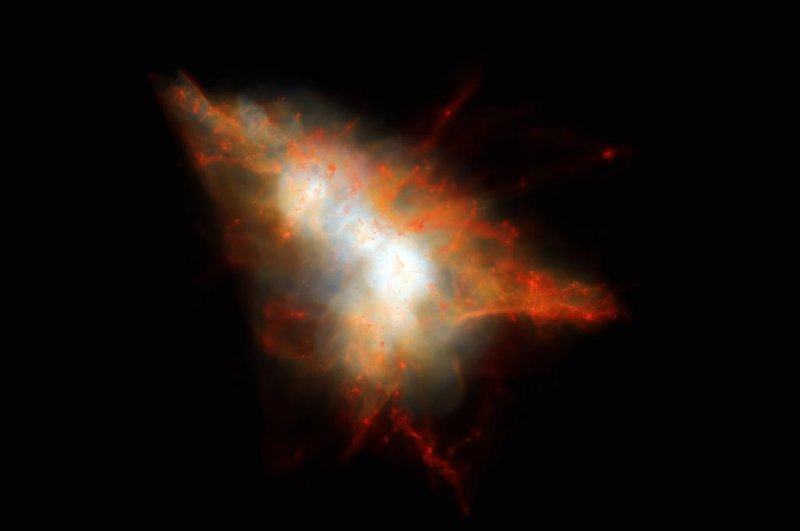Two large, young galaxies are responsible for the intense glow of SSA22-Lyman-alpha blob 1, seen here as rendered by a cosmological simulation. Photo by J.Geach/D.Narayanan/R.Crain
HATFIELD, England, Sept. 21 (UPI) -- Astronomers have long wondered why a distant Lyman-alpha blob, a massive collection of cosmic gas, glowed so brightly. New observations by the Atacama Large Millimeter/submillimeter Array, or ALMA, suggest two young, large and star-rich galaxies are responsible for the blob's luminosity.
ALMA's instruments allowed scientists to peer into the gas clouds with unprecedented clarity. At the center, they found a pair of galaxies churning out new stars 100 times faster than the Milky Way.
The blob in question is SSA22-Lyman-alpha blob 1, or LAB-1. Lyman-alpha blobs are made up of hydrogen gas and can stretch thousands of light-years across. They get their name from the frequency of ultraviolet light they emit, Lyman-alpha radiation.
Most Lyman-alpha blobs are found in the distant universe. LAB-1 is located 11.5 billion light-years away, which means astronomers are seeing the blob as it was 11.5 billion years ago.
Researchers combined their ALMA observations with imagery from the Hubble Space Telescope to better map the region surrounding LAB-1. The blob's pair of galactic light sources are surrounded by several smaller galaxies. The galaxies appear to be coalescing into a galaxy cluster.
Scientists suggest the surrounding galaxies are likely providing material for the duo's rapid star formation. The duo, scientists say, is likely to merge and become an elliptical galaxy.
Researchers used a model designed to simulate galaxy evolution, called Feedback in Realistic Environments, to confirm the source of the blob's glow. The model showed light from the plethora of newly born stars would be absorbed by the hydrogen gas and re-emitted as Lyman-alpha radiation.
The findings were published this week in the Astrophysical Journal.
"Think of a streetlight on a foggy night -- you see the diffuse glow because light is scattering off the tiny water droplets," astronomer Jim Geach, lead author of the new study, said in a news release. "A similar thing is happening here, except the streetlight is an intensely star-forming galaxy and the fog is a huge cloud of intergalactic gas. The galaxies are illuminating their surroundings."
"For a long time, the origin of the extended Lyman-alpha light has been controversial," Geach added. "But with the combination of new observations and cutting-edge simulations, we think we have solved a 15-year-old mystery: Lyman-alpha blob 1 is the site of formation of a massive elliptical galaxy that will one day be the heart of a giant cluster."















